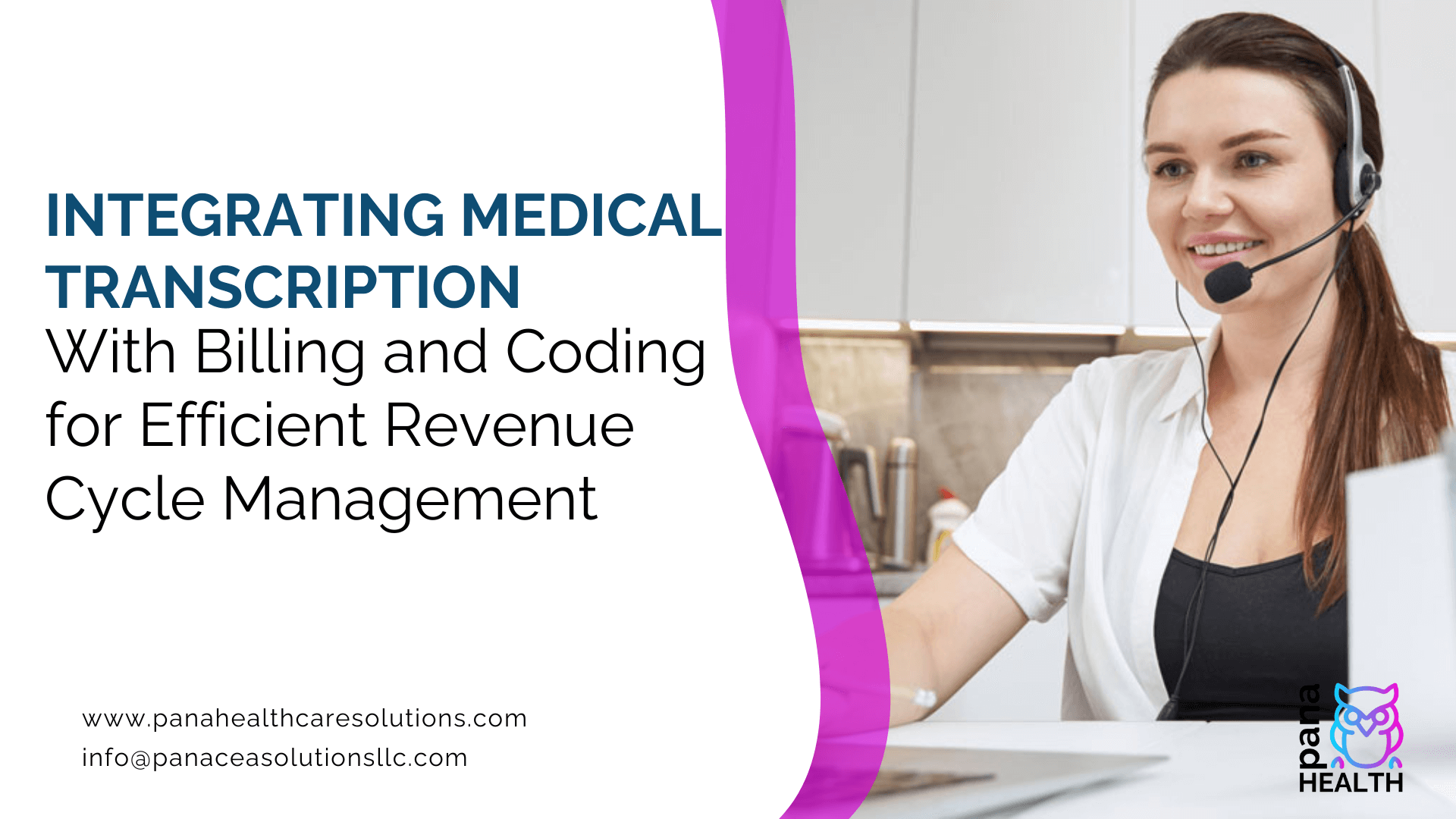Medical transcription is the process of converting spoken medical encounters (doctor’s dictation, progress notes, operative reports, etc.) into written or electronic text that becomes part of the official patient record. It serves as the bridge between the clinician’s narrative and the structured data needed for claims. In practice, high-quality transcription ensures that every diagnosis, procedure, and clinical detail is captured accurately. These transcripts feed directly into the medical coding process, where coders assign ICD-10 and CPT codes based on the documented care. Clear, precise transcripts give coders the exact information they need; when the language is unambiguous and complete, coding is faster and more accurate. In turn, this accuracy is critical for billing. As one medical transcription expert puts it, “accurate medical transcription lays the foundation for precise medical billing and coding”. Without accurate transcription, claims can contain errors (missing modifiers, wrong terms) that lead to denials or delayed payments.
A medical professional reviews dictated notes on a computer, illustrating how clear clinical documentation flows into coding and billing. Integrating transcription with coding and billing ensures notes are accurate and complete, enabling faster claims processing.
Importantly, medical transcription isn’t just about converting words – it also enforces compliance and data integrity. Professional transcriptionists are trained in medical terminology and privacy protocols, ensuring that even complex medical terms are spelled correctly and sensitive information is handled under HIPAA/HITECH rules. In practice, top transcription services routinely achieve 98–99% accuracy by using a blend of AI voice recognition and human review. This high accuracy rate directly reduces coding errors. For example, a study notes that “missing modifiers or unclear terminology lead to coding errors and claim denials,” whereas clear transcripts help coders “assign the correct ICD-10 and CPT codes” with fewer mistakes. In short, by capturing precise, standardized terminology in each report, medical transcription ensures that coders and billers have the clear clinical data they need.
How Transcription Feeds Coding and Billing Accuracy
Accurate transcription directly impacts coding by providing complete clinical narratives. When transcriptionists capture detailed physician notes and flag any ambiguities, coders can identify the exact services provided. As one industry source explains, detailed transcripts “ensure diagnoses and procedures are reported correctly,” which in turn “lowers claim rejections and speeds up payments”. In a properly integrated workflow, transcription and coding work hand-in-hand: coders rely on the rich data in the transcript, and transcriptionists understand coding requirements so they can emphasize key information. For instance, medical transcriptionists trained in coding needs will consistently include critical details (e.g. whether a procedure was left or right-sided, or if a modifier is needed) in their reports, so that the biller sees no missing pieces.
Conversely, errors or omissions in transcription directly cause coding mistakes. Illegible or incomplete notes force coders to guess or query the provider, which delays claim submission. If a transcription missed a mention of a performed service (say, a minor procedure or specific location), the coder may omit a billable code. Numerous studies show that incomplete documentation is a top driver of denials and underpayments. By contrast, practices that adopt rigorous transcription standards see fewer coding denials. For example, integrated teams often implement feedback loops between coders and transcriptionists: the coders can report frequent clarifications needed, and the transcriptionists adjust templates or workflows accordingly. One transcription provider recommends bringing transcriptionists and coders together in regular review meetings, noting that this “reduces back-and-forth on claims and improves overall efficiency in healthcare documentation”. In effect, such collaboration closes the loop between dictation and billing.
The result is tangible: practices that integrate transcription and coding into a single workflow report faster charge capture and higher quality. In one example, a surgical center saw its “transcription, coding, and billing” integrated such that claims “easily pass to each department and decrease the days to bill, increase your efficiency, and improve your rate of collections”. In another case, a community hospital using AI-powered transcription cut its backlog of unbilled cases by 50% and boosted coding productivity by 40%. These improvements all stem from having the right information available to the billing team at the right time.
Impact on Revenue Cycle Efficiency and Claim Acceptance
Integrating medical transcription with coding and billing accelerates the entire revenue cycle. When transcripts are delivered promptly and accurately, coders can file claims quickly – reducing the “time between service delivery and revenue realization”. This swift handoff from dictation to coding means claims enter the payer system sooner, often within days of the patient encounter. Shortening this lag significantly improves cash flow and reduces days in accounts receivable.
Speed is only one factor, however. Integration also increases the clean claim rate – the percentage of claims accepted on first submission. With complete and unambiguous documentation, billers report far fewer edits or resubmissions. For example, a medical transcription service notes that clear transcripts “cut down on coding errors” which in turn “speed up claim approvals and keep your revenue cycle running smoothly”. In real terms, this can mean claim acceptance rates well above the industry average. (Indeed, one RCM provider advertises a clean claim ratio of about 98% for their integrated services.) Each prevented denial not only saves hours of rework but also means that revenue comes in faster.
Denial rates in healthcare remain stubbornly high – averaging around 12–15% of claims nationwide. Even modest reductions translate into big savings. An industry analysis found that reworking a denied claim typically costs about $25 on average (up to $181 for hospitals). By preventing denials up front – through better documentation and coding alignment – practices avoid these costs entirely. It’s estimated that 80–90% of claim denials are preventable with proper procedures in place. Indeed, research shows that with better pre-claim collaboration, tens of millions of dollars in administrative costs can be saved each year and thousands of hours of staff time freed up.
Beyond simple metrics, integrated workflows also reduce compliance and audit risks. Detailed transcripts provide an audit trail. When payers scrutinize claims (especially under value-based reimbursement), every code and service must “trace back to a clean, detailed note”. Proper transcription helps ensure documentation integrity. It also upholds data security: transcription services that are HIPAA-compliant protect patient data, which protects providers from costly fines and legal exposure. In an era of stiffening enforcement (the U.S. Department of Health and Human Services stepped up HIPAA audits and fines in 2024–2025), having HIPAA-safe transcription and billing processes is vital.
Key Revenue Cycle Benefits
- Faster Claim Submission: Timely transcripts mean faster coding and billing. Some providers receive final charge slips the next day, enabling same-day or next-day claims filing.
- Higher First-Pass Acceptance: Clear, complete documentation reduces denials. Practices with integrated transcription-coding report first-pass claim acceptance rates in the high 90s (e.g. ~98% clean claim ratio).
- Fewer Appeals: Each avoided denial saves rework. Preventing one denied claim (costing ~$25–$181 to rework) pays immediate dividends.
- Improved Collections: By reducing delays and denials, net collection rates rise. Panacea Healthcare, for instance, advertises net collection rates around 92% for their integrated RCM clients.
- Audit Readiness: Detailed transcripts support coding defensibility and regulatory compliance, reducing risk of clawbacks in value-based contracts.
In short, when transcription, coding, and billing are integrated, the revenue cycle “runs much more smoothly.” Claims are filed accurately and promptly, denials plummet, and revenue is realized more predictably.
Challenges of Siloed Documentation and Billing Systems
By contrast, when transcription, coding, and billing operate in silos, inefficiencies pile up. In a traditional model, clinicians dictate notes which may sit unprocessed until later; those notes might not automatically connect to the coding or billing teams. This “lack of communication between the clinical and revenue cycle teams” is a top driver of denials. For example, if a transcriptionist does not capture a key detail (or the coder doesn’t receive certain notes in time), claims can be missing information that payers need. Denials then trigger frantic back-and-forth to collect missing data. According to one RCM expert, many health systems see up to 17% of claims denied – often because important details were “locked in documentation silos”.
Typical problems in siloed environments include:
- Delayed Documentation: If transcription turnaround is slow or pushed back, coding waits. Even a day’s delay on a large volume of claims can shift cash flow by weeks.
- Incomplete Data Transfer: Without integrated systems, staff may have to manually transfer information from the transcript to the billing system, introducing transcription errors or omissions.
- Duplication of Work: Nurses or physicians may spend extra time correcting or clarifying notes when billing staff flag uncertainties, instead of seeing patients. (Such non-value work fuels burnout; in fact, one AMA survey found 1 in 5 doctors spend over 8 extra hours per week on EHR tasks after hours.)
- Broken Feedback Loops: In a silo, transcriptionists never hear what coding issues their work caused. When coders find a missing body part or unclear instruction, they may not feed that back. As a result, the same mistakes keep happening.
- Compliance Gaps: Without oversight, security protocols might slip; for example, an unvetted contractor handling dictation could pose HIPAA risks.
These silos also hurt morale. Clerical staff spending hours on appeals or data entry easily become frustrated – the so-called “provider abrasion” crisis. Studies estimate U.S. payers and providers lose billions every year to preventable denials and rework. In the current environment of thin margins and staffing shortages, health systems “cannot afford a status-quo approach to denials”. The solution is to break down silos.
Best Practices for Integrated Transcription, Coding, and Billing
Healthcare leaders recommend several best practices to ensure transcription, coding, and billing work seamlessly together:
- Unify Systems and Workflows: Leverage an integrated EHR/RCM platform or middleware that connects dictation to coding and billing. For example, ContinuumCloud notes that integrated EHR and RCM solutions “help to bridge siloed processes and enable medical billing while reducing the likelihood of denied claims”. When possible, have transcription feed directly into the patient’s electronic chart in real time, so coders always see the latest notes (studies show digitizing progress notes directly into the EMR can “eliminate transcription and reduce human error”). This eliminates manual handoffs and keeps information flowing.
- Speed and Turnaround: Set aggressive transcription turnaround targets. Many practices aim for same-day or next-day completion of reports. Fast transcription means coders get claims-ready documentation sooner. Using a hybrid model (AI-generated draft plus human editor) can accelerate throughput: multiple sources note that AI tools can draft notes quickly while humans validate them, preserving both speed and accuracy. Push notifications or dashboards can also alert coders when new reports are ready, as one surgical center did by using a transcription app that “send[s] push notifications to team members, reminding them to e-sign documents or alerting them when an operative note is ready for coding”.
- Standardization and Templates: Adopt structured templates and checklists in templates to ensure all needed coding elements are captured. For example, operative notes can include fields for laterality, implant details, or anesthesia codes. Transcriptionists should be trained to recognize and document these consistently. Ongoing quality control (QC) audits of transcripts for coding completeness are also valuable.
- Cross-Training and Collaboration: Encourage regular communication between clinicians, transcriptionists, coders, and billers. Many organizations hold periodic “RCM huddles” where common documentation issues are reviewed. As one expert advises, bring these teams together so “they share specific KPIs (like denial rates) … improving transparency and accountability”. Educating providers and staff about how documentation affects claims (for instance, showing examples of denied claims due to missing details) fosters a culture of shared responsibility. Similarly, coders can offer feedback to transcriptionists about frequent ambiguities. This collaborative loop – transcriptionists learning coder pain points and coders understanding clinical context – is a best practice that reduces errors.
- Compliance and Security: Ensure all transcription work is HIPAA-compliant. If outsourcing transcription, choose U.S.-based, credentialed professionals who follow strict privacy protocols (as highlighted by industry leaders, “accurate, HIPAA-compliant transcription” is essential). Use secure, encrypted platforms for file transfers and document storage. Having proper safeguards avoids the heavy fines associated with data breaches.
- Technology Aids: Take advantage of speech recognition and data-entry automation where appropriate. For example, ambient AI tools can capture patient-physician conversations in real time, but they must be used with human oversight. A recent analysis notes that health systems are “pairing AI-generated drafts with credentialed medical transcriptionists who correct medical terminology”. This hybrid model can cut clinician note-taking time dramatically (some doctors report saving up to 3 hours a day with AI note-taking) while preserving accuracy. Integrating coding software into the EHR (e.g. auto-suggesting codes based on transcript) can also speed up billing.
- Denial Monitoring and Analytics: Regularly review claim denials to identify patterns. For instance, if a certain procedure code is often denied, check whether the transcript consistently includes the supporting clinical detail. Use analytics to track clean-claim rates and collection cycles, and adjust transcription/coding practices accordingly. One RCM strategy is to audit denials weekly or monthly to find root causes (bad documentation, outdated codes, etc.) and then update processes to eliminate those causes.
By building an end-to-end workflow with these practices, hospitals and clinics can transform their revenue cycles. Documentation becomes proactive rather than reactive, and billing operates with the full confidence that clinical notes are complete and compliant.
U.S. Healthcare Context and Industry Insights
The importance of integrating transcription and coding is underscored by broader U.S. trends. Documentation burden is a major pain point: an AMA survey found 1 in 5 physicians spend over eight extra hours per week on EHR tasks – a key trigger for burnout. This fuels the shift toward outsourcing transcription. As one analysis notes, physicians are “desperate to reclaim clinical hours” and are increasingly offloading documentation to transcription partners. In fact, industry forecasts estimate about $3.3 billion will be spent on medical transcription in the U.S. in 2025 – a market growing ~5% per year. This growth reflects both telehealth expansion and the realization that clean documentation is a financial necessity in value-based care.
Denial rates remain high in the U.S., emphasizing the need for clean claims. A 2024 report showed nearly 15% of healthcare claims are denied on first submission. With providers spending billions appealing those denials, even small improvements in documentation can pay big dividends. For example, one industry study pointed out that 75% of commercial Medicare Advantage denials in 2023 were later overturned, indicating that most denial work was avoidable in the first place. Effective transcription that captures all relevant details—paired with coder knowledge—can therefore have a huge impact on reducing these avoidable costs.
Regulatory trends also shape the landscape. HIPAA/HITECH enforcement has stepped up sharply (e.g. large fines issued in 2023–2025), and states like California and Texas are layering on their own health data laws. These pressures mean that healthcare organizations cannot afford compliance lapses in transcription or billing. An integrated, secure documentation-to-billing pipeline is one of the best defenses against audits and fines.
Finally, technology is transforming this space. The rise of AI-driven documentation tools suggests the future of transcription will be even more automated. However, experts stress that human oversight remains essential. Successful organizations will be those that adopt AI-enabled transcription (to speed workflows) while ensuring U.S.-based, credentialed staff validate every note. This hybrid approach reflects the cutting edge of how transcription supports coding and revenue cycle automation today.
Conclusion: End-to-End RCM with Panacea Healthcare Solutions
In summary, medical transcription is far more than clerical work – it is a foundational part of clinical documentation that directly impacts coding accuracy, billing speed, and revenue cycle performance. By tightly integrating transcription with coding and billing workflows, healthcare providers can streamline operations, reduce denials, and improve cash flow. Conversely, keeping these functions siloed invites errors, delays, and lost revenue.
The solution is an end-to-end approach. For example, Panacea Healthcare Solutions (panaHEALTH) offers an integrated suite of services spanning medical transcription, coding, billing, and full RCM support. Their model ensures that transcripts flow seamlessly to coding and billing teams, all under one managed workflow. Panacea highlights that such integration delivers measurable results – for instance, their clients achieve a 98% clean-claim ratio and about a 92% net collection rate. These figures reflect the efficiency gains of having transcription, coding, and billing working in concert, supported by HIPAA-compliant processes and certified coders.
Healthcare organizations looking to maximize revenue should consider these integrated services. By partnering with a full-service RCM provider like Panacea, hospitals and clinics can alleviate administrative burdens and focus on patient care. Panacea’s U.S.-based transcription specialists, coders, and billers collaborate in real time to ensure every claim is complete, compliant, and paid promptly.
Ready to improve your revenue cycle? Contact Panacea Healthcare Solutions today to learn how our end-to-end transcription, coding, billing, and RCM services can boost your clean claims rate and collections – so you can keep your “eyes on patients” while we take care of the rest.






